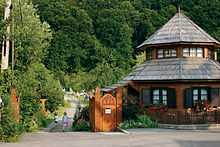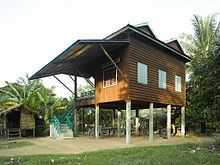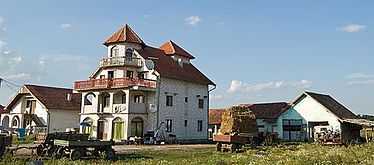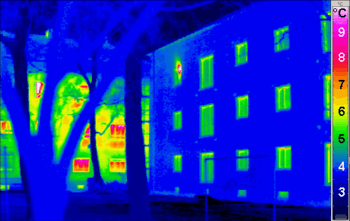House

A house is a building that functions as a home for humans or other creatures like dogs ,[1][2] ranging from simple dwellings such as rudimentary huts of nomadic tribes to complex structures composed of many systems.[3][4]
The social unit that lives in a house is known as a household. Most commonly, a household is a family unit of some kind, although households may also be other social groups or individuals.
Etymology
The English word house derives directly from the Old English Hus meaning "dwelling, shelter, home, house," which in turn derives from Proto-Germanic Khusan (reconstructed by etymological analysis) which is of unknown origin.[5] The house itself gave rise to the letter 'B' through an early Proto-Semitic hieroglyphic symbol depicting a house. The symbol was called "bayt", "bet" or "beth" in various related languages, and became beta, the Greek letter, before it was used by the Romans.[6]
Inside the house
Layout

Ideally, architects of houses design rooms to meet the needs of the people who will live in the house. Such designing, known as "interior design", has become a popular subject in universities. Feng shui, originally a Chinese method of moving houses according to such factors as rain and micro-climates, has recently expanded its scope to address the design of interior spaces, with a view to promoting harmonious effects on the people living inside the house, although no actual effect has ever been demonstrated. Feng shui can also mean the "aura" in or around a dwelling, making it comparable to the real-estate sales concept of "indoor-outdoor flow".
The square footage of a house in the United States reports the area of "living space", excluding the garage and other non-living spaces. The "square metres" figure of a house in Europe reports the area of the walls enclosing the home, and thus includes any attached garage and non-living spaces. The number of floors or levels making up the house can affect the square footage of a home.
Parts
Many houses have several large rooms with specialized functions and several very small rooms for other various reasons. These may include a living/eating area, a sleeping area, and (if suitable facilities and services exist) separate or combined washing and lavatory areas. Additionally, spa room, indoor pool, indoor basketball court, and so forth. In traditional agriculture-oriented societies, domestic animals such as chickens or larger livestock (like cattle) often share part of the house with human beings. Most conventional modern houses will at least contain a bedroom, bathroom, kitchen or cooking area, and a living room. A typical "foursquare house" (as pictured) occurred commonly in the early history of the US where they were mainly built, with a staircase in the center of the house, surrounded by four rooms, and connected to other sections of the home (including in more recent eras a garage).
History of the interior

Little is known about the earliest origin of the house and its interior, but it can be traced back to the simplest form of shelters. Roman architect Vitruvius' theories have claimed the first form of architecture as a frame of timber branches finished in mud, also known as the primitive hut.[7] Philip Tabor later states the contribution of 17th century Dutch houses as the foundation of houses today.
- "As far as the idea of the home is concerned, the home of the home is the Netherlands. This idea's crystallization might be dated to the first three-quarters of the 17th century, when the Dutch Netherlands amassed the unprecedented and unrivalled accumulation of capital, and emptied their purses into domestic space.[8]
Communal rooms

In the Middle Ages, the Manor Houses facilitated different activities and events. Furthermore, the houses accommodated numerous people, including family, relatives, employees, servants and their guests.[7] Their lifestyles were largely communal, as areas such as the Great Hall enforced the custom of dining and meetings and the Solar intended for shared sleeping beds.[9]
Interconnecting rooms
During the 15th and 16th centuries, the Italian Renaissance Palazzo consisted of plentiful rooms of connectivity. Unlike the qualities and uses of the Manor Houses, most rooms of the palazzo contained no purpose, yet were given several doors. These doors adjoined rooms in which Robin Evans describes as a "matrix of discrete but thoroughly interconnected chambers."[10] The layout allowed occupants to freely walk room to room from one door to another, thus breaking the boundaries of privacy.
- "Once inside it is necessary to pass from on room to the next, then to the next to traverse the building. Where passages and staircases are used, as inevitably they are, they nearly always connect just one space to another and never serve as general distributors of movement. Thus, despite the precise architectural containment offered by the addition of room upon room, the villa was, in terms of occupation, an open plan, relatively permeable to the numerous members of the household."[10]
Although very public, the open plan encouraged sociality and connectivity for all inhabitants.[7]
Corridor
An early example of the segregation of rooms and consequent enhancement of privacy may be found in 1597 at the Beaufort House built in Chelsea. It was designed by English architect John Thorpe who wrote on his plans, "A Long Entry through all".[11] The separation of the passageway from the room developed the function of the corridor. This new extension was revolutionary at the time, allowing the integration of one door per room, in which all universally connected to the same corridor. English architect Sir Roger Pratt states "the common way in the middle through the whole length of the house, [avoids] the offices from one molesting the other by continual passing through them."[12] Social hierarchies within the 17th century was highly regarded, as architecture was able epitomize the servants and the upper class. More privacy is offered to the occupant as Pratt further claims, "the ordinary servants may never publicly appear in passing to and fro for their occasions there."[12] This social divide between rich and poor favored the physical integration of the corridor into housing by the 19th century.
Sociologist Witold Rybczynski wrote, "the subdivision of the house into day and night uses, and into formal and informal areas, had begun."[13] Rooms were changed from public to private as single entryways forced notions of entering a room with a specific purpose.[7]
Employment-free house
Compared to the large scaled houses in England and the Renaissance, the 17th Century Dutch house was smaller, and was only inhabited by up to four to five members.[7] This was due to their embracing "self-reliance",[7] in contrast to the dependence on servants, and a design for a lifestyle centered on the family. It was important for the Dutch to separate work from domesticity, as the home became an escape and a place of comfort. This way of living and the home has been noted as highly similar to the contemporary family and their dwellings. House layouts also incorporated the idea of the corridor as well as the importance of function and privacy.
By the end of the 17th Century, the house layout was soon transformed to become employment-free, enforcing these ideas for the future. This came in favour for the industrial revolution, gaining large-scale factory production and workers.[7] The house layout of the Dutch and its functions are still relevant today. The names of parts of a house often echo the names of parts of other buildings, but could typically include:
- Bedroom (or nursery, for infants or small children)
- Box-room / storage room
- Conservatory
- Dining room
- Family room or den
- Fireplace (for warmth during winter; generally not found in warmer climates)
- Foyer
- Front room (in various senses of the phrase)
- Garage
- Hallway / passage / Vestibule
- Hearth – often an important symbolic focus of family togetherness
- Kitchen
- Larder
- Laundry room
- Library
- Living room
- Loft
- Nook
- Office or study
- Pantry
- Parlour
- Pew/porch
- Recreation room / rumpus room / television room
- Shrines to serve the religious functions associated with a family
- Stairwell
- Sunroom
- Swimming pool
- Window
- Workshop
-

Farmhouse in Bhutan
-

Khmer house in Cambodia
-

Traditional house in Colombia
-

Traditional village house in Banaue, Philippines
-

House in Brgule, Serbia
Technology and privacy

The introduction of technology and electronic systems within the house has questioned the impressions of privacy as well as the segregation of work from home. Technological advances of surveillance and communications allow insight of personal habits and private lives.[7] As a result, the "private becomes ever more public, [and] the desire for a protective home life increases, fuelled by the very media that undermine it" writes Hill.[7] Work also, has been altered due to the increase of communications. The "deluge of information",[7] has expressed the efforts of work, conveniently gaining access inside the house. Although commuting is reduced, "the desire to separate working and living remains apparent."[7] In Jonathan Hill's book Immature Architecture, he identifies this new invasion of privacy as Electromagnetic Weather. Natural or man-made weather remains concurrent inside or outside the house, yet the electromagnetic weather is able to generate within both positions.[7] On the other hand, some architects have designed homes in which eating, working and living are brought together.
Construction
In the United States, modern house-construction techniques include light-frame construction (in areas with access to supplies of wood) and adobe or sometimes rammed-earth construction (in arid regions with scarce wood-resources). Some areas use brick almost exclusively, and quarried stone has long provided walling. To some extent, aluminum and steel have displaced some traditional building materials. Increasingly popular alternative construction materials include insulating concrete forms (foam forms filled with concrete), structural insulated panels (foam panels faced with oriented strand board or fiber cement), and light-gauge steel framing and heavy-gauge steel framing.
More generally, people often build houses out of the nearest available material, and often tradition and/or culture govern construction-materials, so whole towns, areas, counties or even states/countries may be built out of one main type of material. For example, a large fraction of American houses use wood, while most British and many European houses utilize stone or brick or mud.

In the 1900s (decade), some house designers started using prefabrication. Sears, Roebuck & Co. first marketed their Sears Catalog Homes to the general public in 1908. Prefab techniques became popular after World War II. First small inside rooms framing, then later, whole walls were prefabricated and carried to the construction site. The original impetus was to use the labor force inside a shelter during inclement weather. More recently builders have begun to collaborate with structural engineers who use computers and finite element analysis to design prefabricated steel-framed homes with known resistance to high wind-loads and seismic forces. These newer products provide labor savings, more consistent quality, and possibly accelerated construction processes.
Lesser-used construction methods have gained (or regained) popularity in recent years. Though not in wide use, these methods frequently appeal to homeowners who may become actively involved in the construction process. They include:
- Cannabrick construction
- Cordwood construction
- Geodesic domes
- Straw-bale construction
- Wattle and daub
- Timber framing
- Framing (construction)
Energy efficiency

In the developed world, energy-conservation has grown in importance in house-design. Housing produces a major proportion of carbon emissions (30% of the total in the UK, for example).[14]
Development of a number of low-energy building types and techniques continues. They include the zero-energy house, the passive solar house, the autonomous buildings, the superinsulated and houses built to the Passivhaus standard.
Earthquake protection
One tool of earthquake engineering is base isolation which is increasingly used for earthquake protection. Base isolation is a collection of structural elements of a building that should substantially decouple it from the shaking ground thus protecting the building's integrity[15] and enhancing its seismic performance. This technology, which is a kind of seismic vibration control, can be applied both to a newly designed building and to seismic upgrading of existing structures.[16]
Normally, excavations are made around the building and the building is separated from the foundations. Steel or reinforced concrete beams replace the connections to the foundations, while under these, the isolating pads, or base isolators, replace the material removed. While the base isolation tends to restrict transmission of the ground motion to the building, it also keeps the building positioned properly over the foundation. Careful attention to detail is required where the building interfaces with the ground, especially at entrances, stairways and ramps, to ensure sufficient relative motion of those structural elements.
Bamboo is an earthquake-resistant material, and is very versatile because it comes from fast-grow plants. Adding that bamboos are common in Asia, bamboo-made houses are popular in some Asian countries.
Found materials
In many parts of the world, houses are constructed using scavenged materials. In Manila's Payatas neighborhood, slum houses are often made of material sourced from a nearby garbage dump.[17]
In Dakar, it is not uncommon to see houses made of recycled materials standing atop a mixture of garbage and sand which serves as a foundation. The garbage-sand mixture is also used to protect the house from flooding.[18]
Legal issues
.png)
Buildings with historical importance have legal restrictions.
United Kingdom
New houses in the UK are not covered by the Sale of Goods Act. When purchasing a new house the buyer has different legal protection than when buying other products. New houses in the UK are covered by a National House Building Council guarantee.
United States and Canada
In the US and Canada, many new houses are built in housing tracts, which provide homeowners a sense of "belonging" and the feeling they have "made the best use" of their money. However, these houses are sometimes built as cheaply and quickly as possible by large builders seeking to maximize profits. Many environmental health issues may be ignored or minimized in the construction of these structures. In one case in Benicia, California, a housing tract was built over an old landfill. Home buyers were never told, and only found out when some began having reactions to high levels of lead and chromium.[19]
Identifying houses
With the growth of dense settlement, humans designed ways of identifying houses and/or parcels of land. Individual houses sometimes acquire proper names; and those names may acquire in their turn considerable emotional connotations: see for example the house of Howards End or the castle of Brideshead Revisited. A more systematic and general approach to identifying houses may use various methods of house numbering.
Animal houses
Humans often build "houses" for domestic or wild animals, often resembling smaller versions of human domiciles. Familiar animal houses built by humans include bird-houses, hen-houses/chicken-coops and doghouses (kennels); while housed agricultural animals more often live in barns and stables. However, human interest in building houses for animals does not stop at the domestic pet. People build bat-houses, nesting-sites for wild ducks and other birds, bee houses, giraffe houses, kangaroo houses, worm houses, hermit crab houses, as well as shelters for many other animals.
Houses and symbolism
Houses may express the circumstances or opinions of their builders or their inhabitants. Thus a vast and elaborate house may serve as a sign of conspicuous wealth, whereas a low-profile house built of recycled materials may indicate support of energy conservation.
Houses of particular historical significance (former residences of the famous, for example, or even just very old houses) may gain a protected status in town planning as examples of built heritage and/or of street scape. Commemorative plaques may mark such structures.
Home ownership provides a common measure of prosperity in economics. Contrast the importance of house-destruction, tent dwelling and house rebuilding in the wake of many natural disasters.
Peter Olshavsky's "House for the Dance of Death"[20] provides a 'pataphysical variation on the house.
See also
- Building
- Functions
- Types
- Boarding house
- Earth sheltering
- Home automation
- Housing estate
- Housing in Japan
- Hurricane-proof house
- Lodging
- Lustron house
- Mobile home
- Modular home
- Summer house
- Tiny house
- Economics
- Miscellaneous
- Institutions
- U.S. Department of Housing and Urban Development
- Lists
- List of American houses
- List of house styles
- List of house types
- List of human habitation forms
- List of real estate topics
- Open-air museum
References
- ↑ Shelter By Lloyd Kahn. Shelter Publications, Inc., May 1, 2000.
- ↑ American Shelter: An Illustrated Encyclopedia of the American Home By Les Walker. Overlook Press, July 1, 1998
- ↑ Schoenauer, Norbert (2000). 6,000 Years of Housing (rev. ed.) (New York: W.W. Norton & Company).
- ↑ "housing papers" (PDF). clerk.house.gov. Retrieved December 18, 2012.
- ↑ "Online Etymology Dictionary". Etymonline.com. Retrieved January 4, 2012.
- ↑ Sacks, David (2004). Letter perfect: the marvelous history of our alphabet from A to Z. Random House Digital. pp. 65–66. ISBN 0-7679-1173-3.
- ↑ 7.0 7.1 7.2 7.3 7.4 7.5 7.6 7.7 7.8 7.9 7.10 7.11 Hill, Jonathan, “Immaterial Architecture”, New York: Routledge, 2006.
- ↑ Tabor, Philip, "Striking Home: The Telematic Assault on Identity". Published in Jonathan Hill, editor, Occupying Architecture: Between the Architect and the User.
- ↑ "Manor House". Middle-ages.org.uk. May 16, 2007. Retrieved January 4, 2012.
- ↑ 10.0 10.1 Evans, Robin “Translations from Drawing to Building: Figures, Doors and Passages” London: Architectural Associations Publications 2005
- ↑ Summerson, John “The Book Of Architecture of John Thorpe in Sit John Soan's museum: 40th Volume of the Walpole Society” England: The Society 1964
- ↑ 12.0 12.1 Pratt, Sir Roger “Sir R. Pratt on Architecture” 1928
- ↑ Rybczynski, Witold (1987). Home: A Short History of An Idea. London: Penguin. p. 56. ISBN 0-14-010231-0.
- ↑ "Energy Performance Certificates - what they are : Directgov - Home and community". Direct.gov.uk. Retrieved January 4, 2012.
- ↑ neesit (April 27, 2007). "YouTube – Testing of a New Line of Seismic Base Isolators". Youtube.com. Retrieved January 4, 2012.
- ↑ James M. Kelly, Professor Emeritus Civil and Environmental Engineering. "Base Isolation: Origins and Development". National Information Service for Earthquake Engineering, University of California, Berkeley.
- ↑ Brown, Andy (2009). "Below the poverty line: living on a garbage dump". Real Lives. UNICEF. Retrieved July 12, 2013.
Slum houses, often made of materials scavenged from the dump site...
- ↑ Nossiter, Adam (May 2, 2009). "In Senegal, Building on Perilous Layers of Trash". The New York Times.
- ↑ "Benicia Suit's `Paltry' Payoff / Plaintiffs' homes built on toxic site". SFGate.
- ↑ http://www.mcgill.ca/files/architecture-theory/olshavsky.pdf
External links
| Wikiquote has quotations related to: House |
 Media related to Houses at Wikimedia Commons
Media related to Houses at Wikimedia Commons
| ||||||||||||||||||||||||||||||
| ||||||||||||||||||||||||||||||

